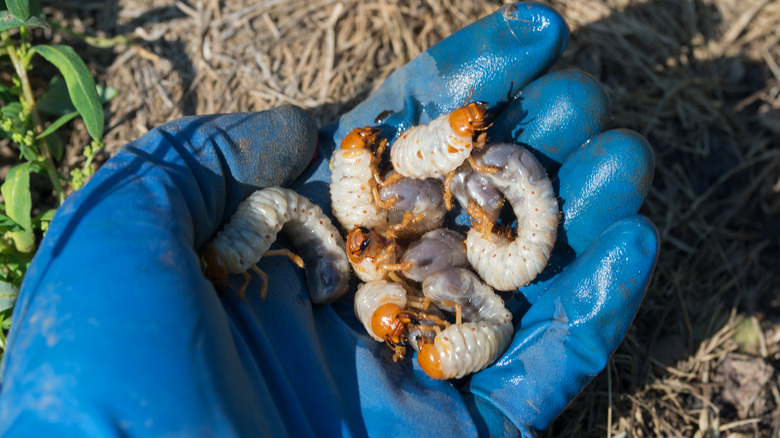What if we picture a lawn as a battleground where we wage war against insidious invaders? Not far from the truth, right? Now, in this epic battle between homeowners and horticultural horrors, few other residential lawn pests have gained as infamous a reputation as the European chafer (Amphimallon majale). The adult beetles, seemingly unremarkable at first glance, are mere harbingers of the devastation their larval offspring will inflict. Measuring a modest ½-inch in length, these unassuming beetles boast a uniform tan or light brown exoskeleton that belies the chaos beneath.
The European chafer’s offspring, those voracious C-shaped, 1-inch-long white grubs, are the true architects of your lawn’s destruction. Sporting a dark, menacing section at the end of their abdomen, these six-legged ravagers brandish a brown head capsule with visible chewing mouthparts. Unfazed by the plethora of grass species, European chafer grubs gorge on grass roots with a single-minded determination that leaves only ruin in their wake. So, it’s time to face the cold, hard truth: European chafers are not just a passing nuisance but a genuine threat to your turf’s survival. You must brace yourself for battle and reclaim your grass from their grasp as early as possible.
European chafer damage on lawns

Decimation! That’s one of the few words that accurately encompasses the destructive wake the European chafer grubs leave behind. Unlike pests that mar the aesthetic appeal of your lawn with nibbled leaves and gnawed stems, these voracious grubs attack the very foundation of your green haven: the roots. They stage their attack from late summer till early winter, then return between March and early May. The first strike of this tiny terror on your lawn becomes noticeable as an unusual sponge-like underfoot sensation, signaling a hidden network of chafer tunnels beneath. Your once lush and firm lawn then easily peels away from the soil, having suffered incredible root damage. If this wasn’t disheartening enough, the advent of drier weather presents another blow. Under this stressful condition, plants cannot grow new roots to replace those gnawed by the grubs, intensifying the lawn’s dire appearance with brown patches.
The real heartbreak comes in early spring. Instead of embracing a vibrant shade of green, the traumatized turf may persist in displaying a dull brown and, in severe cases, may die entirely during prolonged periods of dryness. However, the lawn damage doesn’t stop at brown patches. The devoured roots destabilize the turf, setting up your lawn for collateral damage as it becomes a feeding ground for predators with a taste for grubs (think birds, skunks, and raccoons). The aftermath is a lawn resembling a war movie scene, torn and dug up, a far cry from its past glory.
How do you get rid of European chafer from your lawn?
Preceding any intervention to regain your lawn’s health is a little scouting expedition. With a square-end shovel, unearth a 2-inch thick square foot of sod, then check the grub count to classify the infestation scale. Five to 10 grubs per square foot signal the need for intervention. There are two options for European chafer grub insecticides: preventative and curative. Preventative contenders, featuring ingredients like chlorantraniliprole, imidacloprid, and thiamethoxam, enter the scene from June to mid-July. These ambush the grubs that would’ve otherwise hatched within the following three months. However, spray them early before the grubs grow too mighty.
Curative contenders like carbaryl and trichlorfon flex their muscles between August and October or early March before the arrival of spring. Spring application won’t tip the scales in your favor here; the larvae could have already dealt a significant blow to your lawn. Don’t discharge these chemicals near flowering plants, given their danger to your yard’s pollinators. Safety gear — long pants, rubber gloves, boots, a mask, and eye protection — is a must when handling these potent solutions.
But let’s say you’re wary of using chemicals. In that case, nematodes — specifically Heterorhabditis bacteriophora — emerge as a natural counter to these grubs. To prepare for nematode application in July, mow your lawn at 2 to 3½ inches, leaving the clippings. Pre- and post-application watering ensures the nematodes penetrate the soil effectively.
